New Riparian Woodland Meadow
BACK TO FULL TOUR
Garden Features
Edible Garden
California Natives
Deer Resistant
Drip Irrigation
Pesticide Free
Rainwater Harvesting System
Rain Garden
Reclaimed/Recycled Materials
Smart Irrigation Controller
Lawn Conversion
Lawn-Free Landscaping
Permeable Surfaces
Wildlife Habitat
Partner: Santa Rosa Water
The transition from a townhouse with a modest garden to a spacious half-acre property in Rincon Valley marked the beginning of an exciting new chapter in our lives. Recognizing the magnitude of the project, we enlisted the expertise of a landscape architect and professional landscaper to help bring our vision to life.
Situated alongside the unmanicured preserve along Austin Creek, the front garden underwent a remarkable transformation by the end of June, boasting over 400 native plants and a large dry creek bioswale designed to retain rainwater on the property. The absence of fencing allowed for a seamless integration of our land with the adjacent native space, creating a sweeping vista of natural beauty.
Mindful of wildlife, particularly deer, we carefully selected “deer-resistant” plants and took precautions to protect our young plantings. Fortunately, the abundance of rainfall in the previous year alleviated the need for deer to forage extensively, giving our plants time to establish themselves.
Embracing sustainability, we repurposed existing materials wherever possible, including rocks for the bioswale and organic matter for mulch in the garden. The result is a vibrant ecosystem teeming with life, where birds flit among the grasses, bees buzz around Verbena De La Mina, and butterflies dance among the native flora.
Among the myriad of native plants that grace our garden, we take particular delight in the buckwheat, native fuchsia, Epilobium “Everett’s Choice,” Joyce Coulter ceanothus, Matilda Poppies, and Achilles “Island Pink.” Complementing our commitment to environmental stewardship, we’ve installed solar panels with battery backup, adopted an electric car, and upgraded to energy-efficient mini-split heating systems. Simple yet effective changes, such as painting the south-facing front doors red to reduce heat absorption, further underscore our dedication to sustainability.
In embracing our new home and garden, we’ve not only created a sanctuary for ourselves but also a haven for native wildlife and a testament to the transformative power of conscientious living.
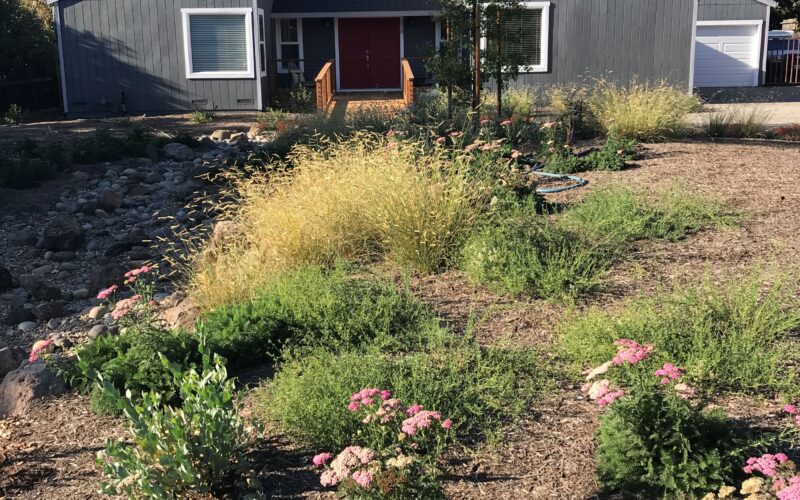
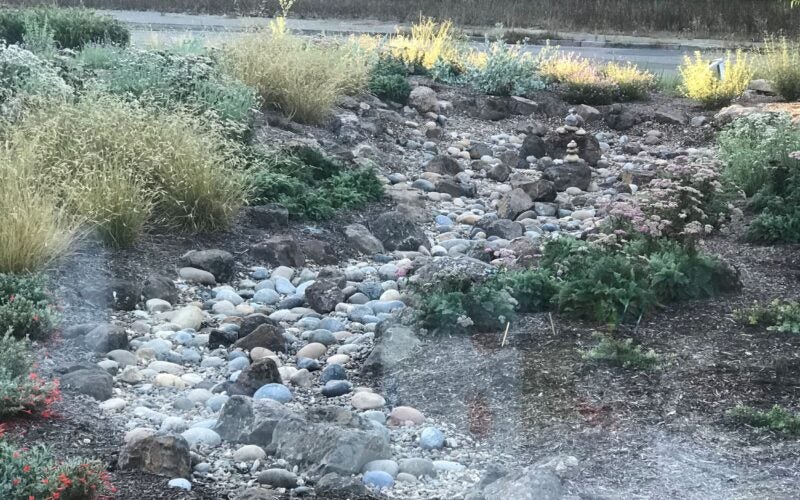
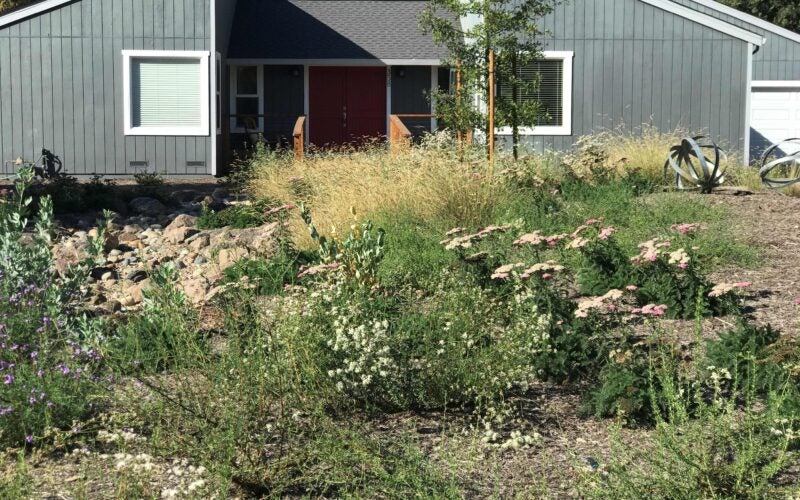
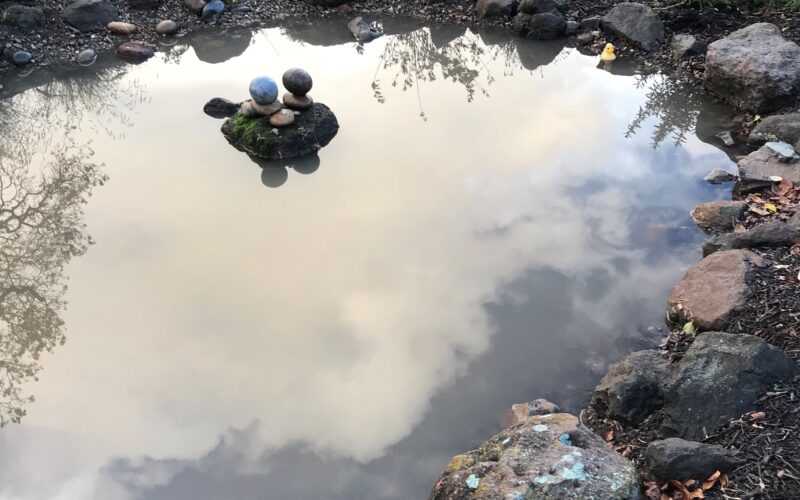
Plants in this Garden
-
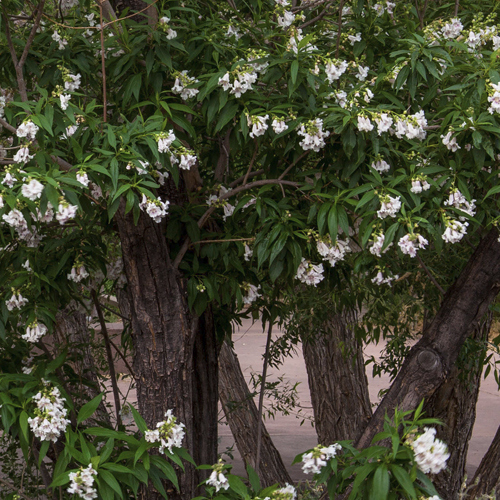
Chitalpa tashkentensis Chitalpa
-
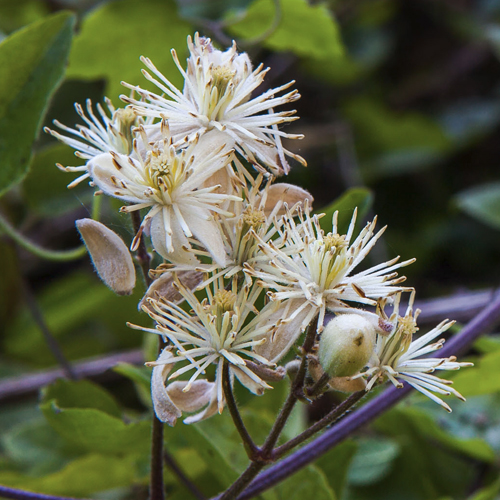
Clematis lasiantha Pipestem Clematis
-
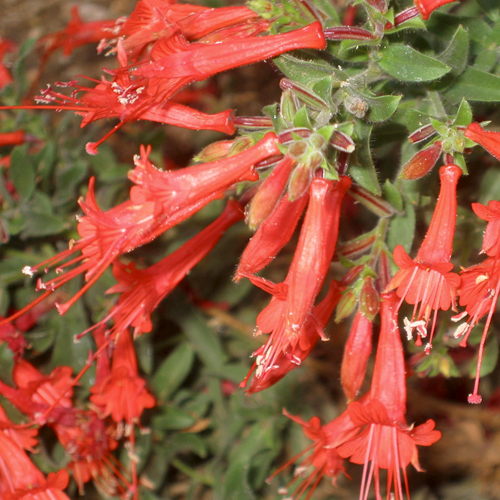
Zauschneria [Epilobium] spp California Fuchsia
-
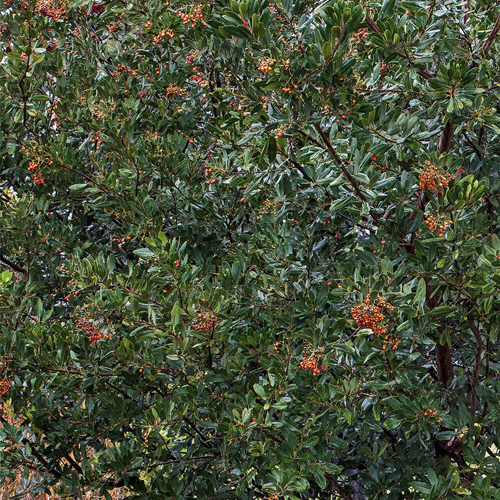
Heteromeles arbutifolia Toyon
-
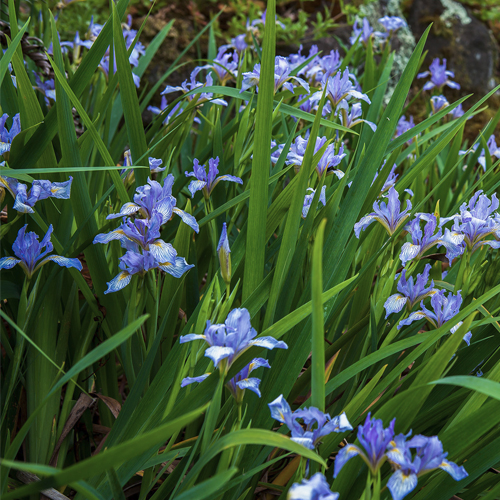
Iris douglasiana & cvs Douglas Iris, Pacific Coast Hybrids
-
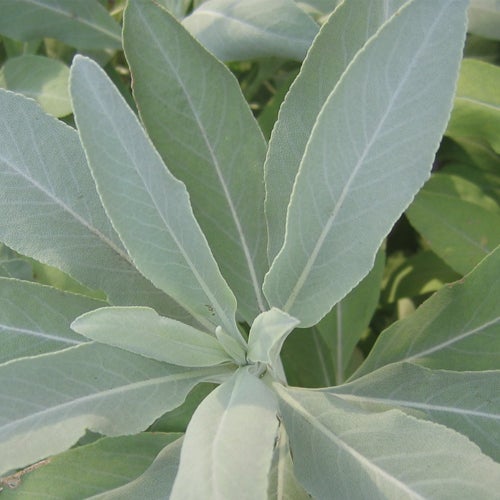
Salvia spp Sage
-
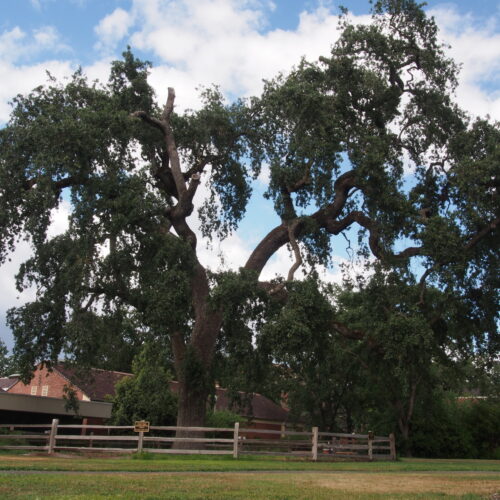
Quercus lobata Valley Oak
-
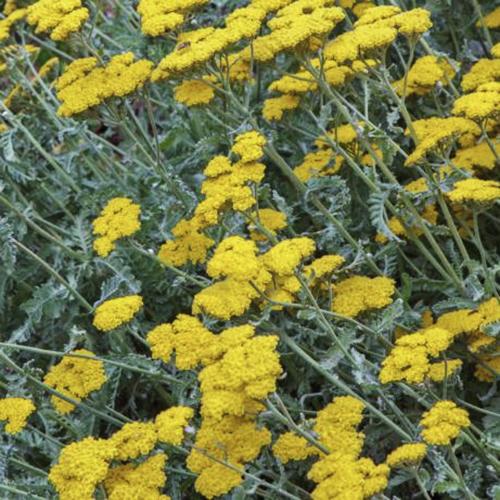
Achillea spp & cvs Yarrow
-
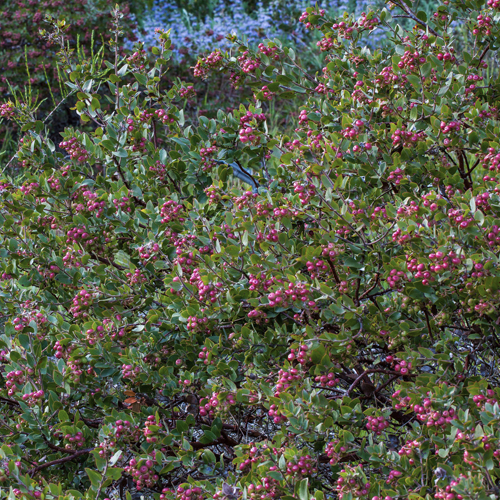
Arctostaphylos spp & cvs Manzanita, 'Dr. Hurd'
-
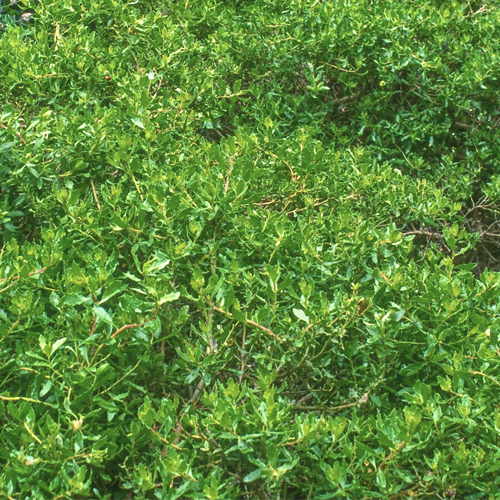
Baccharis pilularis & cvs Dwarf Coyote Bush
-
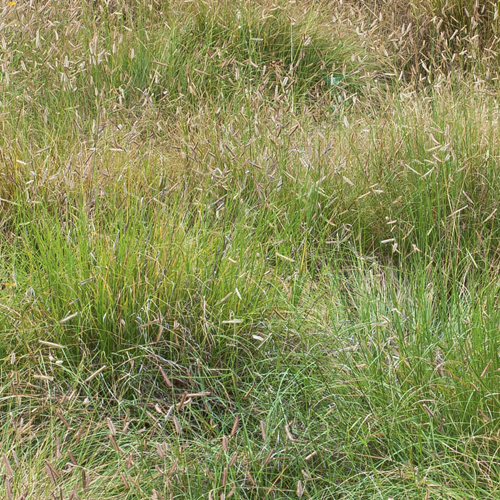
Bouteloua gracilis Blue Grama Grass
-
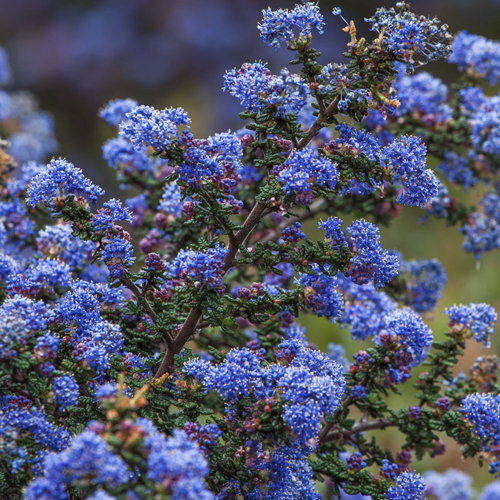
Ceanothus spp & cvs Ceanothus
-
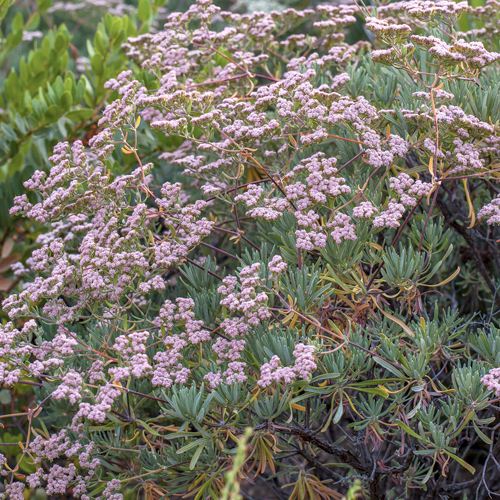
Eriogonum spp Buckwheat
-
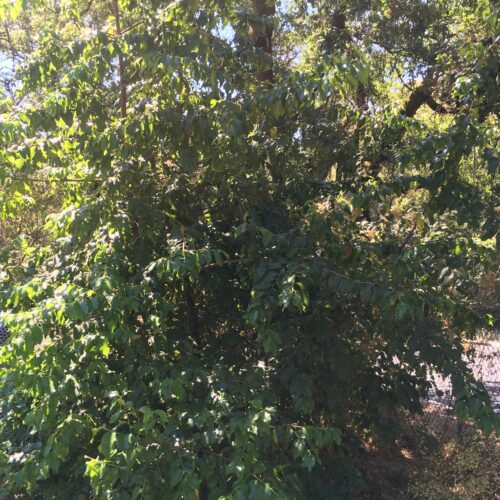
Prunus ilicifolia Holly Leaf Cherry
-
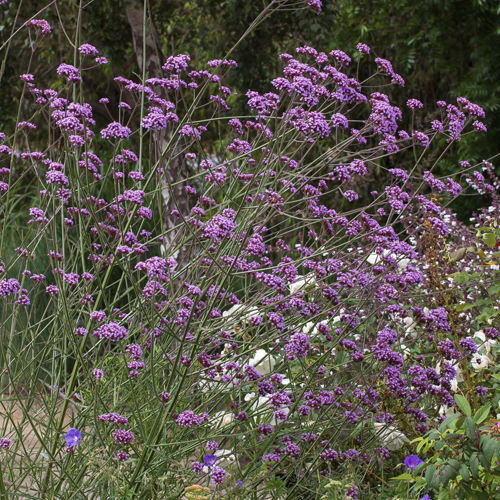
Verbena spp Verbena

Fast-growing, medium-sized, deciduous tree with clusters of showy trumpet-shaped flowers from late spring to fall. Chitalpa is a sterile hybrid between Catalpa bignonioides, common catalpa, and Chilopsis linearis, desert willow. It combines the larger flowers of the former and the drought-tolerance of the latter. Since the flowers are sterile, they do not form seed pods or fruit. There are two popular cultivars, ‘Pink Dawn’ with lavender-pink flowers and ‘Morning Cloud’ with white flowers.
- Water: Low
- Light: Full Sun
- Soil: Well Drained

The deciduous pipestem clematis is native to dry foothills of California and Baja California and is one of the few flowering vines that requires little-to-no supplemental water. Pipestem clematis produces an abundance of 1-inch, creamy white flowers in spring that develop into attractive, fluffy seed heads. Allow to grow through shrubs or trees or train on a pergola, archway, or fence.
- Water: Low
- Light: Full SunPartial Shade
- Soil: Most Soils

Group of highly variable, semi-evergreen subshrubs and herbaceous perennials distributed over a wide geographic area, including California. Epilobiums bloom in late summer with tubular flowers providing a food source for hummingbirds migrating south and are also attractive to bees and butterflies. Epilobiums range from low-growing groundcovers to upright plants of several feet. Flower colors include orange-red, white, pink, and salmon. Most can be pruned back in late autumn to maintain a more compact form and be rejuvenated for the following year.
Low-growing examples: E. ‘Schieffelin’s Choice’; E. canum ‘Calistoga’, a selection from Phil Van Soelen from California Flora Nursery from the Palisades east of Calistoga; E. canum ‘Cloverdale’, a selection from U.C. Santa Cruz Arboretum from along the Russian River north of Cloverdale with exceptionally orange flowers; E. c. ‘Everett’s Choice’, E. c. ‘Summer Snow’ with white flowers, and E. septentrionale ‘Select Mattole’, a somewhat redder flowering selection that is more shade-tolerant.
Upright examples: E. c. ‘Bowman’s Hybrid’ (2-3’), E. c. ‘Catalina’ (3-4’), E. c. ‘Liz’s Choice’ (3’) selected by Milo Baker Chapter CNPS Fellow Liz Parsons, E. c. ‘Marin Pink’ (2’) with pink flowers.
- Water: Low
- Light: Full Sun
- Soil: Well Drained

California native, evergreen shrub or small tree often seen growing in Sonoma and Marin county wildlands. Lacy, white flower clusters in spring attract pollinators; red berries in winter provide a splash of color and an important food source for birds. The name “Hollywood” was born from the abundance of toyon in the hills of southern California and its resemblance to European holly. The cultivar ‘Davis Gold’ has yellow berries and may be more disease-resistant than the species.
- Water: Low
- Light: Full SunPartial Shade
- Soil: Well Drained

Iris are a large and diverse group of perennials that grow from either bulbs or rhizomes. The California native Douglas iris and cultivars known as Pacific Coast Hybrids are an excellent choice for summer-dry gardens and understory plantings. Fall rain brings new growth in the form of thin, upright leaves, followed in late winter to early spring by the first blossoms. Douglas iris commonly ranges in color from lavender to purple, but cultivars are available in a range of colors including white and yellow. Established plantings can be lifted and divided after the first significant fall rain and either replanted or put into containers to share with others.
- Water: Low
- Light: Partial ShadeShade
- Soil: Most Soils

Salvias are a huge group of more than 900 species that include annuals, perennials, and shrubs adapted to a variety of climates and have varying water requirements. Salvias are attractive to hummingbirds, butterflies, and bees, and are generally ignored by deer. Sages that are native to California are generally drought-tolerant, prefer full sun, and little to no fertilizer. Annual pruning in late summer or fall generally helps to keep plants tidy and healthy.
CA native sages:
- S. apiana, white sage (3-4’ x 4-6’), silvery-white, aromatic leaves with tall flower spikes of white flowers, popular for honey production and in bundles as a natural incense.
- ‘Bee’s Bliss’ (1-2’ x 6-8’), superb, light gray groundcover with light purple flowers on long spikes; damp conditions can cause mildew which will clear with warm weather and sunny conditions.
- S. clevelandii, Cleveland sage (3-5’ x 3-5’), medium-sized shrub for hot, dry locations known for pleasant fragrance and deep blue whorls of flowers; popular cultivars include S. c. ‘Allen Chickering’, S. c. ‘Pozo Blue’, and S. c. ‘Winnifred Gilman’.
- S. leucophylla, purple sage, includes plants with both an upright growth habit, such as S. l. ‘Amethyst Bluff’ (3-5’ x 3-5’) and others with a sprawling form, such as S. l. ‘Point Sal’ (2-3’ x 6’), both of which are from Santa Barbara county.
- S. sonomaensis, Sonoma sage (1-2’ x 3-4’), groundcover that prefers light shade and will not tolerate damp conditions; cultivars include S. s. ‘Dara’s Choice’, S. s. ‘Greenberg Gray’, and S. s. ‘Hobbit Toes’.
- S. spathacaea, hummingbird sage (1-2’ spreading), herbaceous groundcover that grows well in dry shade and spreads slowly by underground rhizomes; large leaves have a wonderful fruity fragrance; the only red-flowered native sage.
- S. mellifera, black sage (6′ x 10′), evergreen shrub that grows well in full sun and well drained soils. Dark green leaves with pale purple flowers in late spring and early summer.
Non-native sages:
- S. chamaedryoides, germander sage (2-3’)
- S. chiapensis, Chiapas sage (1-2’ x 3-4’)
- S. greggii, autumn sage (1-4’ x 1-4’)
- S. leucantha, Mexican bush sage (3-4’ x 3-6’)
- S. microphylla, cherry sage (3-4’ x 3-6’)
- S. officinalis, garden sage (1-3’ x 1-3’)
- Water: Very LowLowModerate
- Light: Full SunPartial Shade
- Soil: Well Drained
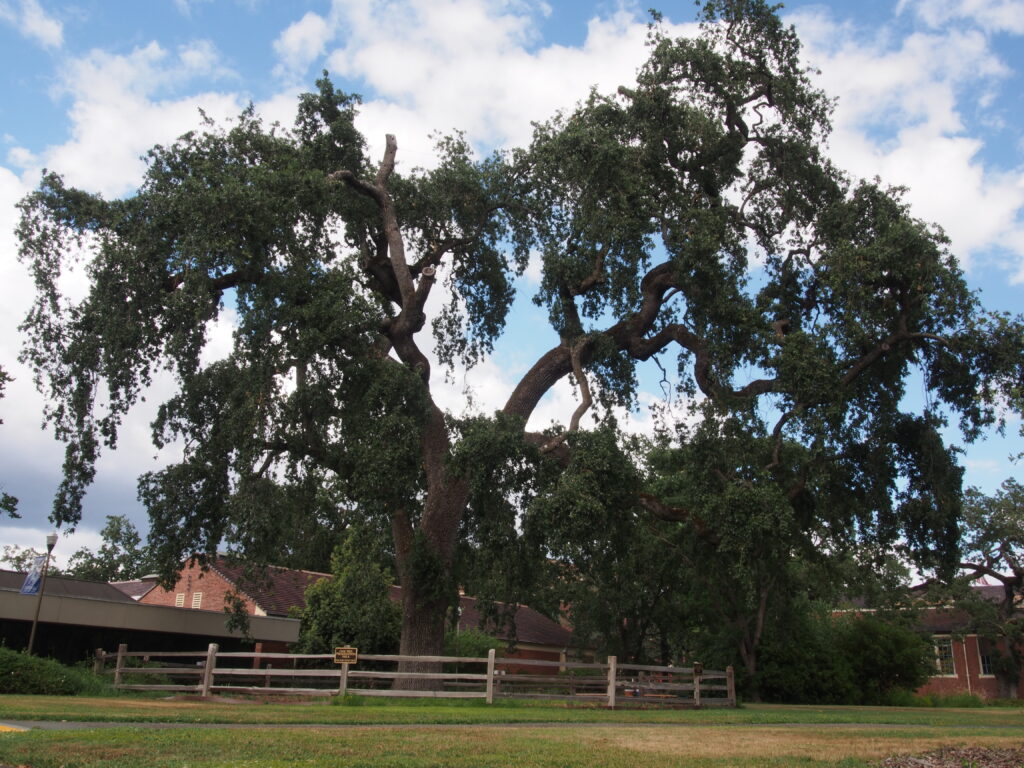
Woody perennial, deciduous tree. Fast growing and one of the best local natives for large properties. Dark green leaves and dark brown to pale gray, ridged bark. Not susceptible to Sudden Oak Death.
- Water: Low
- Light: Full Sun
- Soil: Well Drained

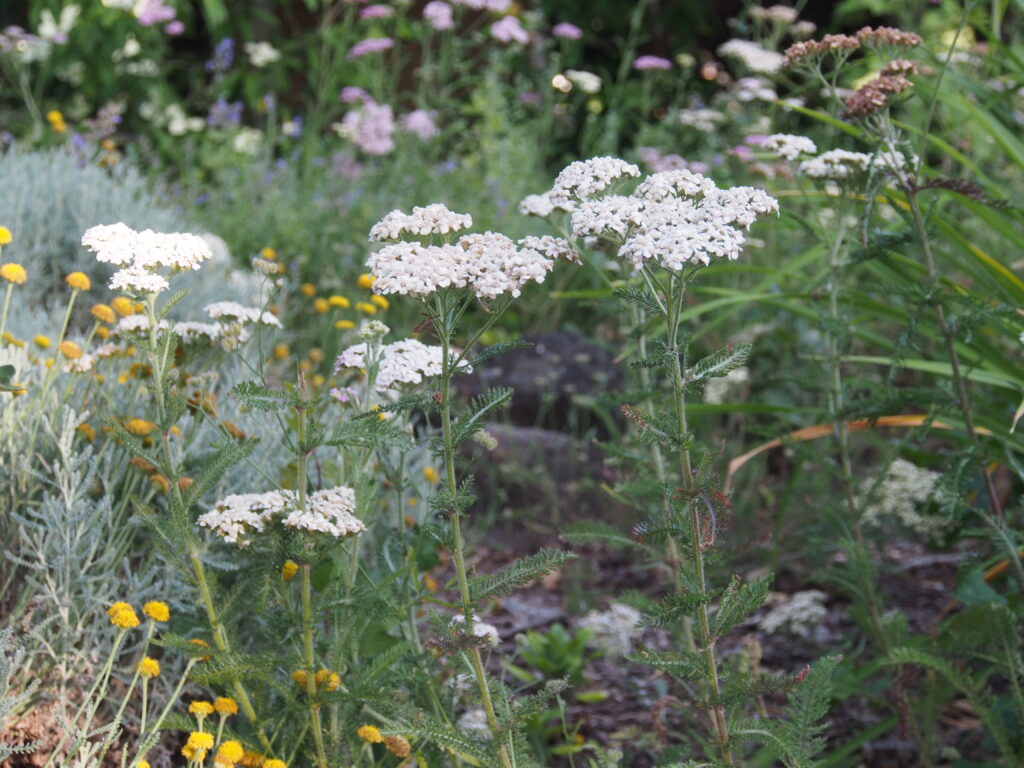
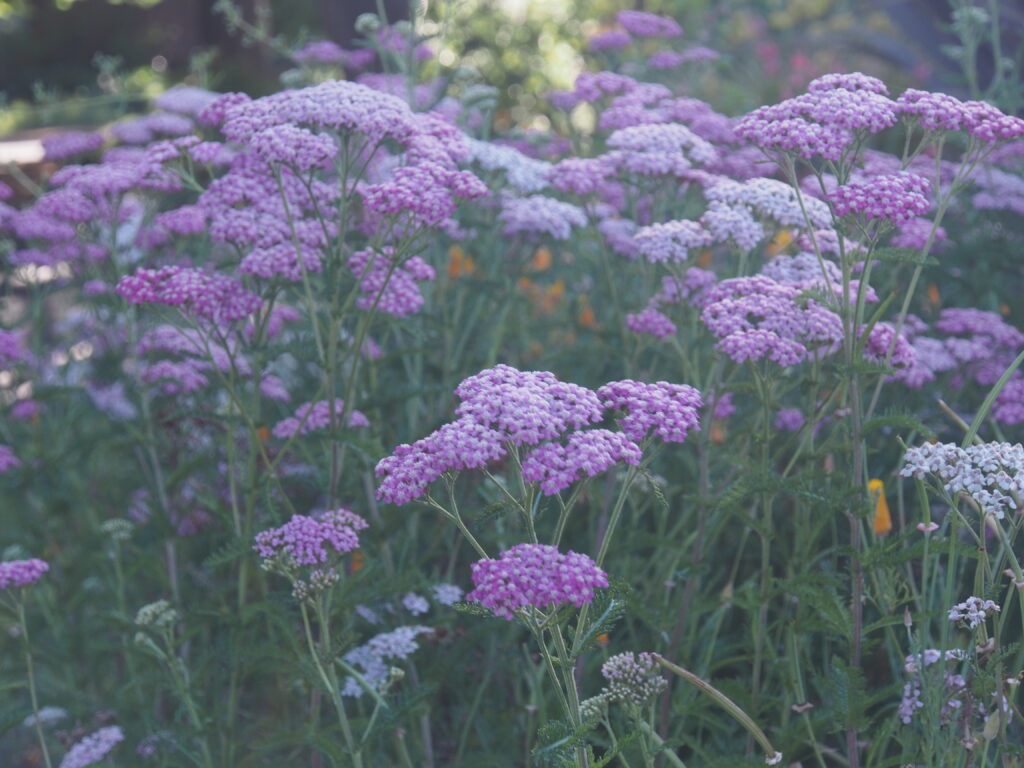
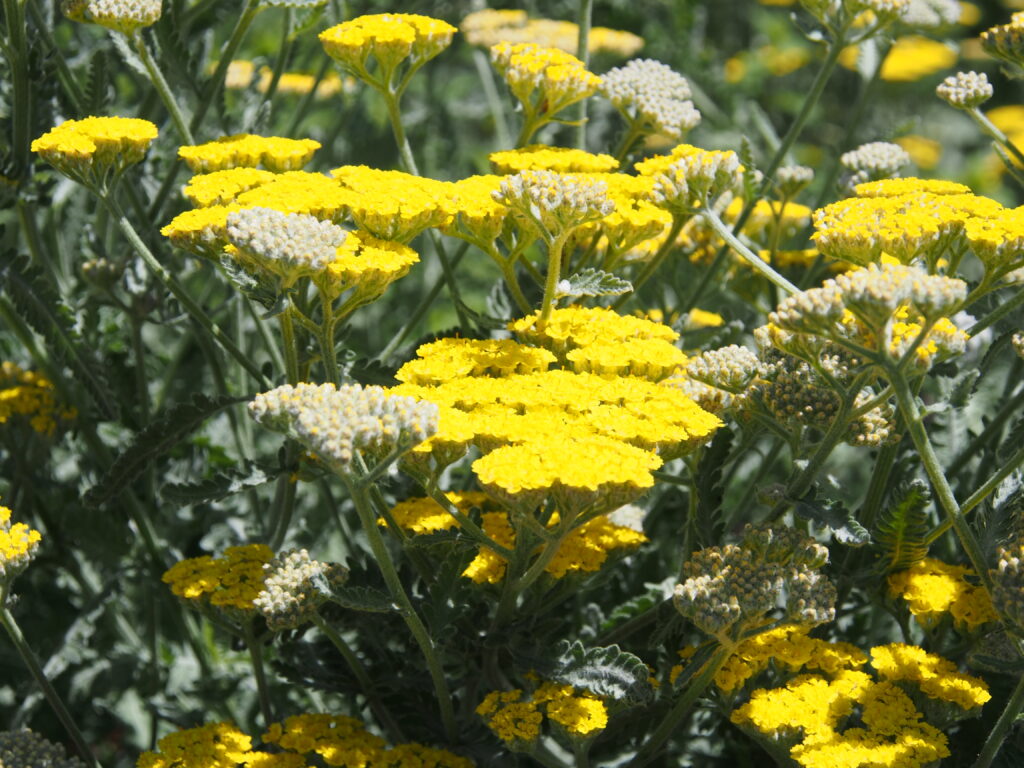
Yarrows are variable low-growing, spreading herbaceous perennials with finely divided leaves that inhabit many temperate regions in the Northern Hemisphere. Flattish clusters of flowers form in spring and well into summer and provide an important nectar source for pollinators and insects. Yarrow can help to stabilize slopes and is a good addition to the upper level of rain gardens and swales. Colors include yellow, pink, and red.
California native spp & cvs: A. millefolium (common yarrow), A. m. ‘Calistoga’, A. m. ‘Island Pink’, A. m. ‘Sonoma Coast’, A. m. ‘Terracotta’.
Other yarrows: A. filipendulina (fern leaf yarrow), A. f. ‘Coronation Gold’, A. ‘Moonshine’, A. tomentosa (woolly yarrow).
- Water: Low
- Light: Full SunPartial Shade
- Soil: Most Soils

Manzanitas vary from carpet-forming groundcovers to small trees. Manzanitas have varying shades of striking, reddish brown bark and can provide structure to a garden. These plants have evergreen foliage, small white-to-pink, urn-shaped blossoms in late winter to early spring, and then small fruits that resemble tiny apples.
Groundcovers: A. ‘Emerald Carpet’ (1’ x 3-6’), A. ‘Pacific Mist’ (2-3’ x 6-8’), A. nummularia ‘Bear Belly’ (1’ x 3’), A. uva ursi ‘Radiant’ (6” x 4-6’), A. uva ursi ‘Wood’s Compct’ (1’ x 3’).
Shrubs: A. ‘Howard McMinn’ (5-7’ x 6-10’), A. ‘John Dourly’ (3-4’ x 5-6’), A. ‘Lester Rowntree’ (8-10’ x 10-15’), A. ‘Sunset‘ (5-7’), A. bakeri ‘Louis Edmunds’ (8-10’), A. manzanita ‘Sentinel’ (6-8’ x 5’), A. hookeri ‘Wayside’ (3′ x 8′).
Trees: A. manzanita ‘Dr. Hurd’ (10-15′)
- Water: Very LowLow
- Light: Full SunPartial Shade
- Soil: Well Drained

Flowers are inconspicuous but provide a source of pollen, nectar, and seeds for wildlife. Shrubby varieties can be cut back to maintain a more tidy and compact appearance. Perennial varieties can be divided in fall or early spring. Excellent choice as support for more showy plants in the garden.
- Water: Low
- Light: Full Sun
- Soil: Most Soils

North American native, warm-season bunchgrass with narrow, grayish green leaves. Ornamental flowers like small brushes form at right angles to slender stems during the summer and persist for many months. Blue grama is adapted to heat, drought, cold, and foot traffic. It does not thrive in shade or wet soils. Blue grama can be used in small clumps among other plants, in a mass as part of a meadow, or even as a lawn substitute. B. g. ‘Blonde Ambition’ is a popular and robust cultivar.
- Water: Low
- Light: Full Sun
- Soil: Well Drained

Ceanothus is a group of fast-growing, evergreen shrubs that vary from groundcovers to small trees, many of which are native to California. They provide a spectacular display of flowers in spring that will attract a multitude of pollinators. Flowers are followed by seeds that provide food for birds. The clusters of tiny flowers range from white to deep violet. Plants perform best with good drainage and minimal irrigation once established. Some do best in cooler coastal climates, but many thrive in hotter inland climates. Pay close attention to the mature size when selecting ceanothus to ensure that it has sufficient space for its natural form.
Groundcovers: C. ‘Centennial’ (1’ x 8’), C. gloriosus var. gloriosus ‘Anchor Bay’ (2’ x 8’), C. griseus var. horizontalis ‘Diamond Heights’ (variegated, 1’ x 4’), C. griseus var. horizontalis ‘Yankee Point’ (3’ x 12’), C. maritimus (2’ x 6’).
Shrubs: C. ‘Blue Jeans’ (6’ x 6’), C. Concha (6’ x 6’), C. ‘Dark Star’ (6’ x 8’), C. ‘Joyce Coulter’ (4’ x 12’), C. ‘Julia Phelps’ (8’ x 10’), C. cuneatus (8’ x 8’), C. thyrsiflorus ‘Skylark’ (4’ x 6’).
Large shrubs: C. ‘Frosty Blue’ (10’ x 12’), C. thyrsiflorus (20’ x 20’), C. t. ‘Snow Flurry’ (white flower, 20’ x 20’).
Trees: C. ‘Ray Hartman’ (15′ x 15′)
- Water: Very LowLow
- Light: Full SunPartial Shade
- Soil: Well Drained

Diverse group of flowering, evergreen shrubs and perennials and annuals found throughout the western United States. Most available in nurseries are native to California and generally prefer drier sites. Flowers colors include yellow, white, pink, and red and are held above foliage in umbels that dry over time and are popular in flower arrangements. Buckwheats provide pollen and nectar for bees and butterflies, larval food for butterflies, seeds for birds, and cover for many creatures.
Examples:
- Santa Cruz Island buckwheat (E. arborescens, 3-4’ x 4-5’) densely mounded with white flowers.
- Saffron buckwheat (E. crocatum, 1-2’ x 2-3’) with chartreuse-yellow flowers and pale leaves.
- California buckwheat (E. fasciculatum, 2-3’ x 3’) and its low-growing cultivars such as E. f. ‘Warriner Lytle.’
- Catherine’s lace (E. giganteum, 4-8’ x 6-10’) with delicate, white flowers and soft pale leaves.
- Red-flowered buckwheat (E. grande var. Rubescens, 1-2’ x 2-3’) low-mounding perennial with rose-pink flowers, coastal bluff buckwheat (E. latifolium, up to 12” x 1-2’.)
- Sulfur buckwheat (E. umbellatum, 6-18” x 1-3’) with intense yellow flowers and cultivars E. u. var. aureum ‘Kannah Creek’ and E. u. Var. ‘Shasta Sulphur’.
- Water: Very LowLow
- Light: Full SunPartial Shade
- Soil: Well Drained
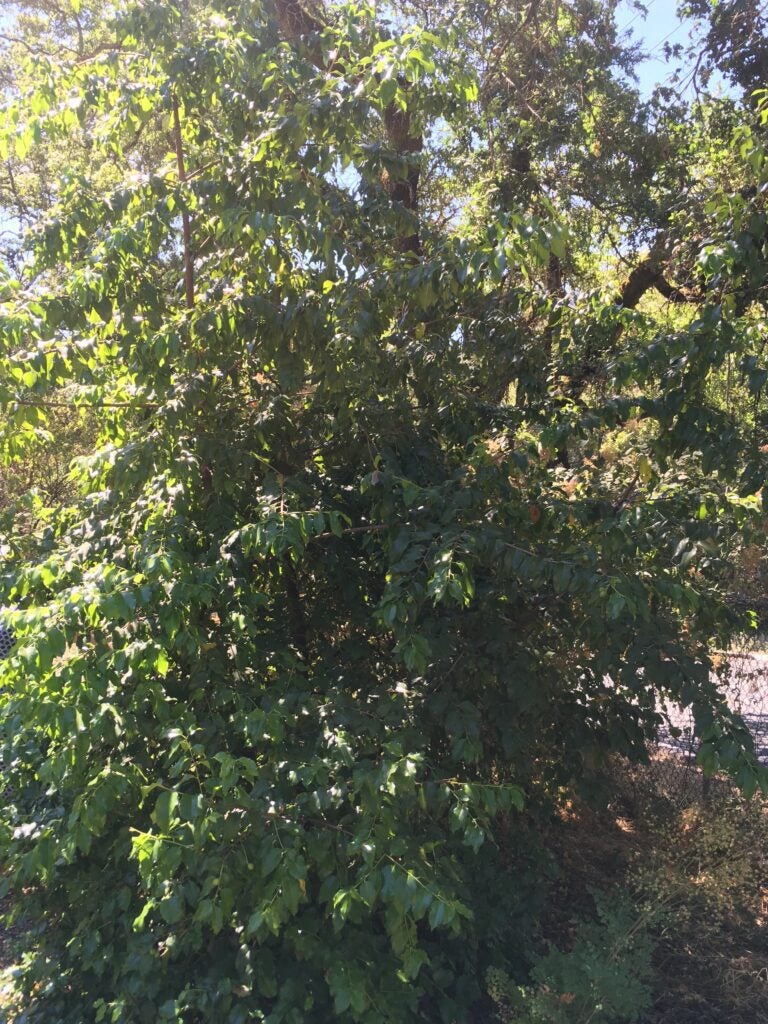
Evergreen shrub, or small tree, with leathery, glossy, dark green leaves. Leaves have spiny, narrow spikes and white flowers in spring. In fall, there are reddish to purple fruits. California Native, specifically to coastal mountains and foothills.
- Water: Low
- Light: Full SunPartial Shade
- Soil: Well Drained

Fast-growing perennials that thrive in hot locations and produce clusters of small, showy flowers in summer.
Examples:
- V. bonariensis (3-6’ x 2-3’) is an upright perennial from South America with long, airy flower stalks. Reseeds readily and should not be planted near riparian areas where it can be invasive.
- Garden verbena (V. x hybrida, 6-12” x 2-3’) is a popular and showy groundcover available in many colors.
- Cedros Island verbena (V. lilacina ‘De La Mina’, 1-2’ x 2-3’) from the Cedros Island off the coast of Baja California is a popular native for its deep purple flower color and uniform growth habit.
- Water: Very LowLow
- Light: Full Sun
- Soil: Well Drained
Favorite Garden Suppliers
Cal Flora Nursery
2990 Somers Street Fulton